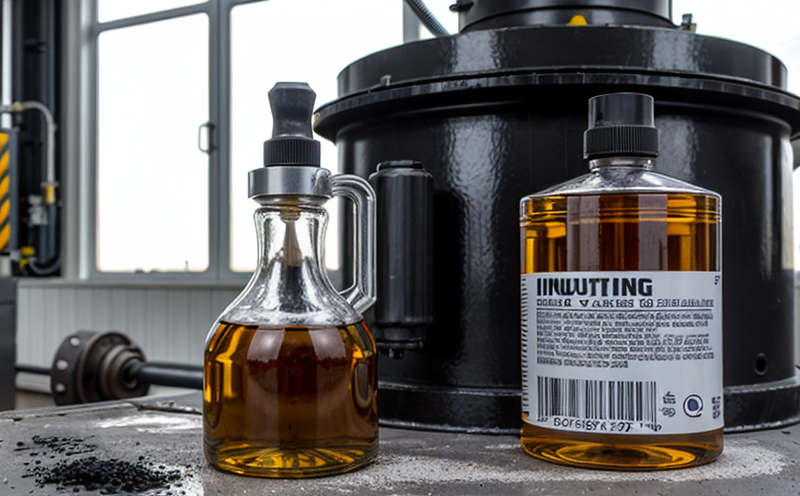JIS K2284 Carbon Residue Testing in Oils
The JIS K2284 standard is a critical tool used to assess the carbon residue content of petroleum oils and lubricants. This test evaluates how much solid carbon remains after heating an oil sample under specific conditions. The procedure is essential for quality assurance, compliance with industry standards, and ensuring that industrial oils meet the required specifications.
The JIS K2284 test follows a standardized process to ensure consistency across different laboratories. Typically, this involves weighing out approximately 1 gram of oil sample into a crucible, which is then placed in an oven at 500°C for two hours under a nitrogen atmosphere. After cooling, the remaining carbon residue is weighed and compared against initial weights.
The test results provide valuable insights into several aspects of industrial oils:
- Indication of oil oxidation: High carbon residues suggest increased levels of oxidative degradation, which can lead to reduced performance and shortened lifespan of lubricants.
- Pollution indicators: Carbon residue content helps identify potential contamination sources, aiding in the maintenance of production equipment.
- Quality control: Regular testing ensures that products comply with industry standards like JIS K2284.
The methodology used in this test is governed by the Japanese Industrial Standard (JIS), which is widely recognized for its stringent quality and reliability. Compliance with such standards is crucial for companies operating within sectors reliant on high-quality industrial oils, including automotive manufacturing, aerospace engineering, and chemical processing.
Our laboratory adheres strictly to JIS K2284 guidelines to ensure accurate, reliable test results. This commitment to precision is reflected in our state-of-the-art facilities and experienced technical staff who understand the nuances of this testing process.
Scope and Methodology
The scope of JIS K2284 carbon residue testing covers the evaluation of petroleum oils and lubricants used in various industrial applications. The primary objective is to measure the amount of solid carbon remaining after heating, which provides a quantitative assessment of oil oxidation.
The methodology involves several steps:
- Sampling: A representative sample is taken from the bulk oil or a specific batch.
- Weighing: Approximately 1 gram of the sample is accurately weighed into a crucible.
- Heating: The crucible containing the sample is placed in an oven set at 500°C for two hours under nitrogen gas to prevent oxidation from atmospheric oxygen.
- Cooling and Weighing: After cooling, the crucible is weighed again to determine the mass of carbon residue.
The difference between the initial weight of the sample and the final weight after combustion provides a direct measure of the carbon residue content. This value can then be compared against industry standards or historical data to assess quality and compliance.
Our laboratory uses modern equipment calibrated according to JIS K2284 specifications, ensuring accurate and repeatable results every time. Our team of experts is well-versed in these procedures, providing clients with confidence that they are receiving the highest quality service available.
Benefits
Carbon residue testing according to JIS K2284 offers numerous benefits across multiple sectors:
- Quality Control: Regular testing helps maintain consistent product quality, ensuring that industrial oils meet the necessary specifications.
- Pollution Prevention: By identifying potential sources of contamination early on, companies can implement corrective actions to prevent further degradation and extend equipment lifespan.
- Cost Efficiency: Early detection of issues allows for proactive maintenance, reducing downtime and associated costs. It also helps in optimizing lubricant usage, thereby lowering operational expenses.
- Compliance Assurance: Meeting stringent industry standards like JIS K2284 ensures that products are up to date with current regulations, enhancing a company's reputation among clients and stakeholders.
- Risk Management: Understanding the carbon residue levels in industrial oils allows for better risk assessment and mitigation strategies, protecting both assets and personnel from potential hazards.
In summary, JIS K2284 testing is an indispensable tool for maintaining high standards of product quality and operational efficiency within industries that rely heavily on lubricants and petroleum products.
International Acceptance and Recognition
The JIS K2284 test is not only recognized within Japan but also widely accepted internationally. Many countries, including the United States, Europe, and China, reference this standard in their own regulatory frameworks.
- America: ASTM D525 Test Method for Carbon Residue of Petroleum Products (By Weight) closely mirrors JIS K2284 in terms of methodology and application.
- European Union: EN ISO 17906:2013 aligns with JIS K2284, emphasizing the importance of standardized testing across borders.
- China: GB/T 265-1988, a national standard for carbon residue determination in petroleum products, is also based on principles similar to those outlined in JIS K2284.
This international recognition underscores the significance of adhering to such standards when conducting quality assessments. By doing so, companies can ensure compatibility across different markets and regulatory environments.





